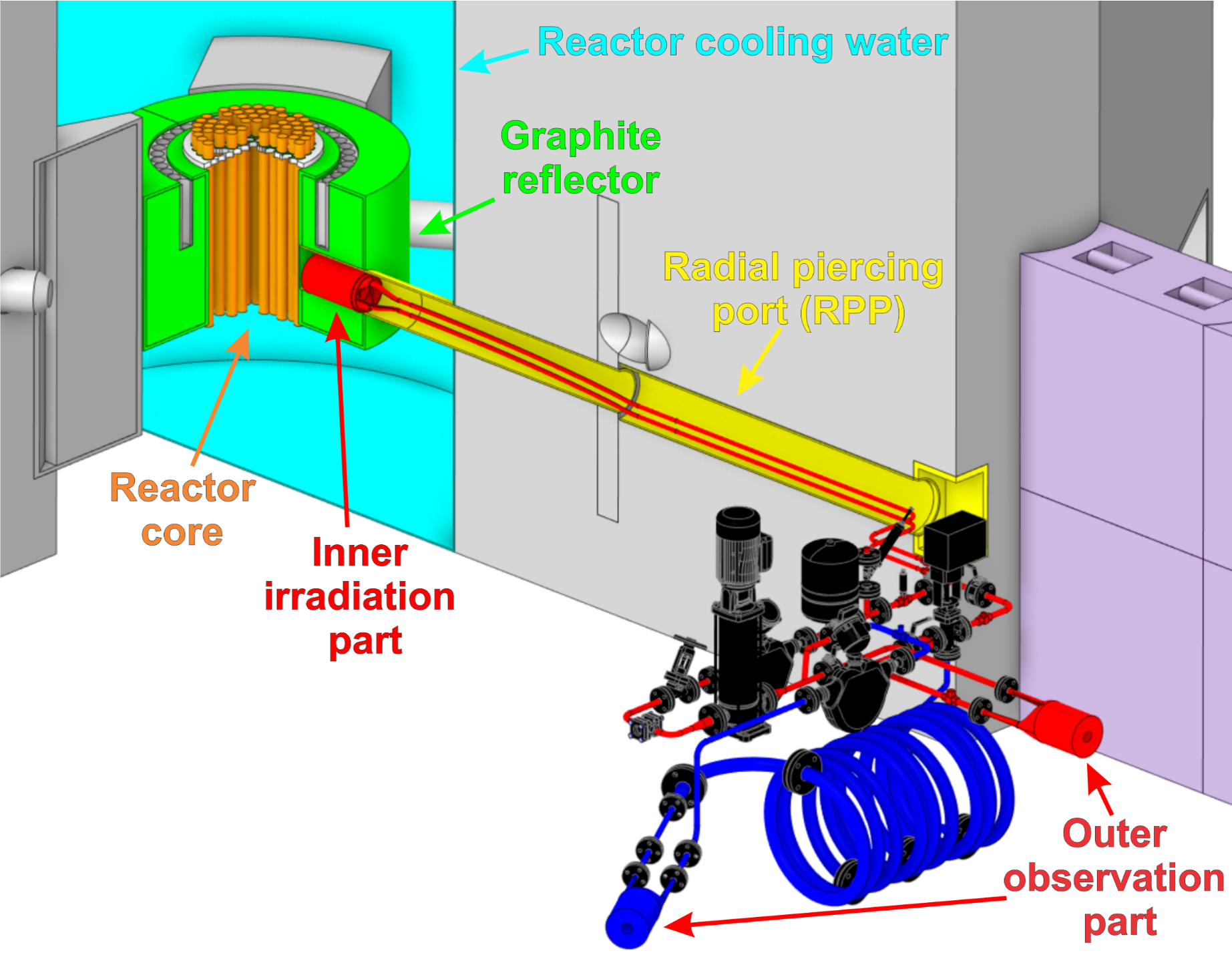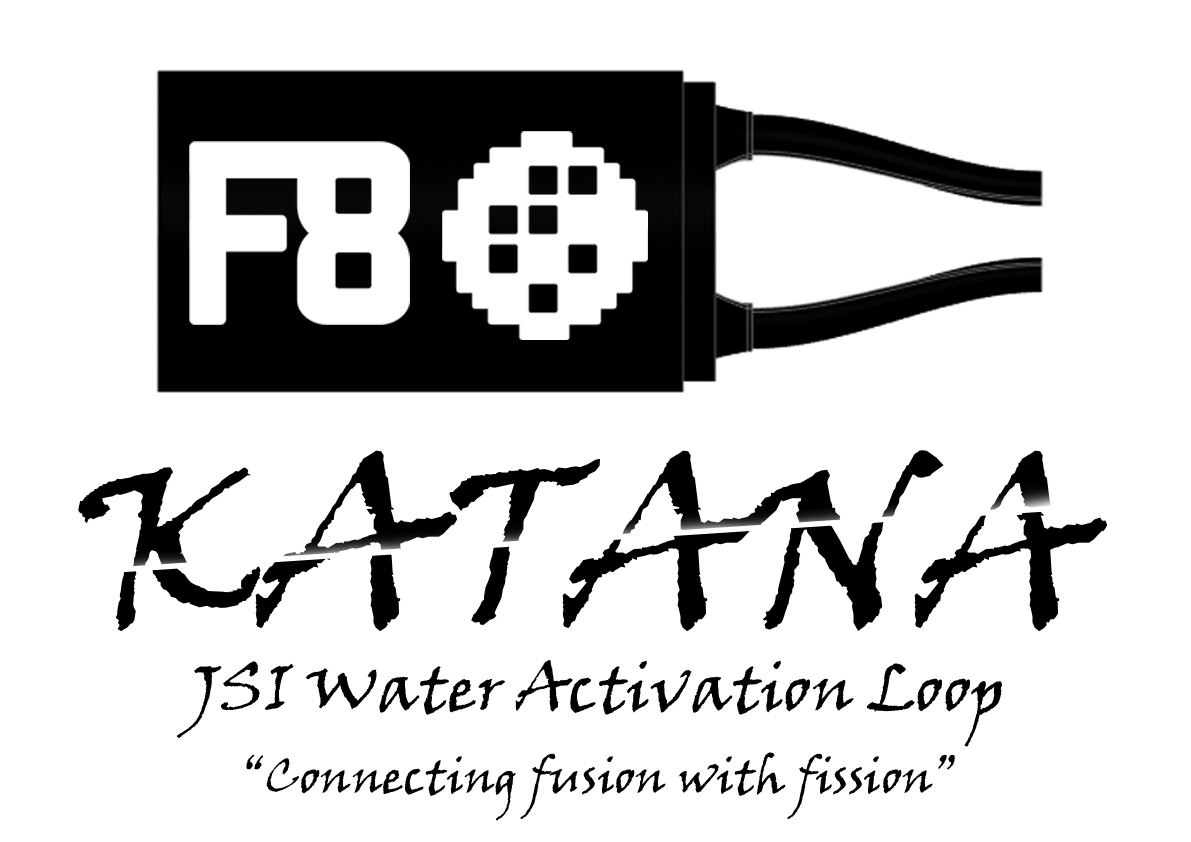

 |
 |
|
The KATANA water activation facility is located in the hall of the TRIGA Mark II nuclear reactor of the “Jožef Stefan” Institute (JSI).
It was designed and built for research into water activation under fusion-relevant conditions.
The TRIGA reactor at JSI can be operated in both steady-state and pulsed mode.
This enables continuous measurements on the KATANA device over several hours and the possibility to simulate the operating regime of fusion reactors.
KATANA will provide detailed insights and the possibility to validate calculation methods for the water activation process under fusion-relevant conditions and much more, which is directly relevant for the preparations for the operation of the large fusion research reactor ITER.
The basic concept of the water activation loop system consists of a pipe loop partially inserted into the Radial Piercing Port (RPP). The three main components are: the "inner activation part", which is located inside the radial piercing port in close proximity to the reactor core and where most of the water activation process takes place, narrow "transport tubes" that lead the activated water outside of the RPP towards the "outer observation part" of the loop, around which various gamma and neutron detectors are arranged. All the necessary equipment, e.g. pump, flow meters, temperature/pressure sensors, water filling system, etc., is located outside the RPP. The main objective of the design optimisation was to create a flexible and compact experimental setup that will enable benchmark quality experiments on the water activation process. For this reason two loops, primary and secondary, were considered. The primary loop should be as short as possible to achieve a high total activity of N-16 and N-17 within the outer observation part, which leads to a lower experimental uncertainty, e.g. for performing shielding experiments using ITER relevant materials. Furthermore, by using a 3-way valve, the water can be fully or partially distributed between the primary and secondary loop, i.e. to mimic leakage between the loops. Such a so-called decay or delay loop allows a longer travel time of the activated water, resulting in a N-16/O-19 isotope ratio in favour of O-19. The use of these two distinct loop components, each optimised for its specific function, enhances the overall performance and accuracy of the system. To ensure personnel safety, the experimental area is surrounded by thick concrete blocks arranged in maze-like configuration to provide a low radiation background in the reactor hall. KATANA experimental campaignsThe KATANA water activation facility at the Jožef Stefan Institute's TRIGA research reactor represents an important step forward in supporting fusion energy research. This innovative facility, which was developed as part of the EUROFusion work package Preparation of ITER Operation (WP PrIO), is used to simulate the behavior of cooling circuits in fusion reactors. By irradiating water for activation and measuring the resulting isotopic composition, researchers gain crucial insights into material behavior and system performance relevant to the ITER operating environment. KATANA enables the investigation of radionuclide production, system calibration techniques and detector performance, bridging the gap between theory and practical application.Recently, five intensive experimental campaigns took place at the KATANA facility as part of WP PrIO, aimed at addressing the key challenges of water activation in future fusion reactors. More than 30 researchers from ten research groups took part in the campaigns, illustrating the collaborative nature of this ambitious project. On 26 test days, the JSI TRIGA reactor was in operation for more than 200 hours and provided the necessary platform for a variety of tests and measurements. Fifteen experimental measurement systems were deployed, each carefully tailored to collect critical data on water activation under fusion-relevant conditions. The focus of these campaigns was to provide experimental data on the water activation process to validate computational methods developed to model the ITER cooling circuit. In addition, different detectors were used to utilise different measurement techniques for the measurement of mixed high-energy gamma and neutron fields.
KATANA computational toolThe KATANA computational tool models the water activation loop using a conventional analytical approach, divided into four sections: the irradiation region (inner irradiation Snail), the observation region (outer Snail No. 1), and two transport regions (pipes and pump). The circuit is discretised into uniform volume elements of 21.65 cm^3 , which are sequentially transported through the simulated loop. For each time step Δt, the specific activity of a given isotope in each volume element is calculated.The computational tool is implemented in the Python programming language and can model a wide range of irradiation scenarios and loop geometries. Two main loop configurations are available: the short loop, optimized for radionuclides with short half-lives (N-16 and N-17), and the decay loop, which enables measurements of longer-lived activation products (O-19). In addition, the tool allows simulation of both flow transients and reactor power transients, providing flexibility for benchmarking experiments and validation studies under real experimental conditions. Uncertainties in the KATANA computational tool are evaluated by combining contributions from nuclear data uncertainties, statistical uncertainties from Monte Carlo transport calculations, and the averaging of reaction rates across the irradiation volume. You can find the computational tool here: GitHub Repository. |
JSI TRIGA Mark II research reactor hall with KATANA experimental area

JSI KATANA experimental setup
|
The primary objectives of the KATANA JSI Water Activation Loop include:
Project supported by:
 |
 |
 |

|
